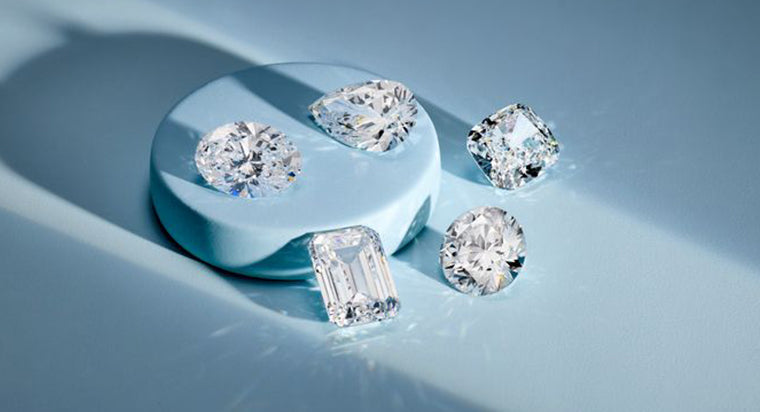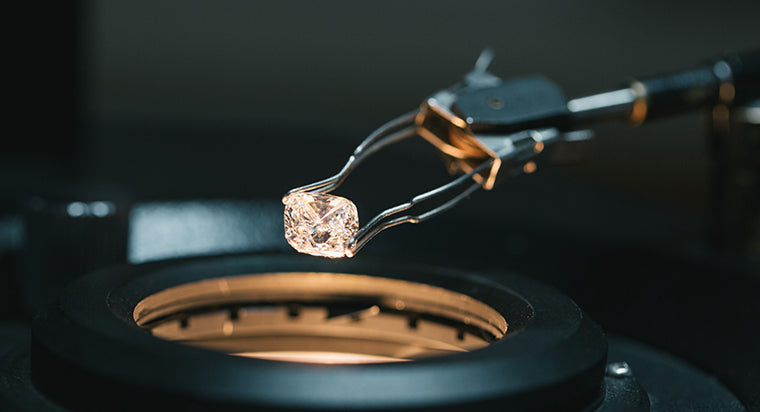Cushion Cut Diamonds
Cushion cut diamonds, also referred to as the mine cut or old mine cut, derive their name from the shape, which resembles a pillow. What is a cushion cut diamond exactly? These loose diamonds are square or rectangular in shape, but unlike the princess cut diamond, their corners are rounded. Although generally less brilliant than round brilliant diamonds, cushions have more fire. Whether it's this fire or their distinctive soft, rounded corners with a square shape that attracts buyers, the cushion cut has successfully claimed its spot as the third most popular diamond shape. But if you plan to shop for one of these popular stones, you'll need to know your way around their different styles and their ratios. We'll break down traditional cuts, which have fewer but larger facets, and modern cushions or modified cushion brilliants, which have as many or more facets as a round brilliant, so you can focus on one thing: how to get the best cushion cut diamond possible.
TABLE OF CONTENTS
A Brief History of the Cushion Cut Diamond
The origins of this beautiful diamond, and why it has a couple names, traces back to the 19th century. The cushion cut diamond wasn't always known as that - in the past, the shape was originally referred to as the mine cut and, eventually, the old mine cut. The mine cut was a square diamond that had rounded corners. It was named after the Brazilian diamond mines. Once diamonds were discovered later in South Africa, the Brazilian diamond mines became known as the “old mines.” So, naturally, the stone named after the mines got a name change, too.
But this mine cut or old mine cut is different than the modern cushion cut that you know now. The old mine cut had 33 crown facets and 25 pavilion facets (58 total facets). Instead of 58 facets like the old mine cut had, the modern cushion cut has 64 facets. Essentially, the modern cushion cut resembles a cross between the old mine cut and a modern oval cut. But what that means for you is that you'll notice modern cushions have more brilliance than their old mine counterparts.
Cushion Cut Diamond Rings have a Following
And you'll probably recognize some of this cut's biggest fans. There are many celebrities today who wear a cushion cut diamond engagement ring, including Ashley Tisdale, Molly Sims, Jennifer Garner, Ivanka Trump, Naya Rivera, and Kelly Rowland. It is a very popular cut, but not just because it's the stone of choice for some celebrity engagement rings. Many of the world’s most famous and largest diamonds are the cushion cut. This includes the Hope Diamond (which has a hefty weight of 45.42 carats), the yellow Tiffany Diamond (which weighs an incredible 128.54 carats), and the Regent Diamond (which is a whopping 140.5 carats). Here's a peek at the celebrity engagement rings that feature this shape of stone:
- Molly Sims shows off a one-of-a-kind cushion cut engagement ring with a diamond halo and micropave band desiner by her partner, Scott Stuber
- Giuliana Rancic flashes her 4-carat cushion halo engagement ring that features three micropave bands with a split shank
- Miley Cyrus' ring from Liam Hemsworth shows off a 3.5-carat cushion diamond set in an intricate yellow gold band
- Jennifer Garner got a cushion cut diamond solitaire set in platinum from Ben Affleck that he picked up at Harry Winston
- Mena Suvari sports an elaborate three stone engagement ring that highlights a 8.6-carat cushion diamond at the very center
- Meghan Trainor loves her 2.5-carat cushion engagement ring from Daryl Sabara that's set in platinum with a diamond halo accent
- Jessica Biel's unique engagement ring has a 6-carat cushion diamond at the center but also side stones that are her birth stone, the aquamarine
- Iggy Azalea got an 8.2-carat cushion cut fancy yellow diamond ring with diamond halo and accents from her now ex-partner, Nick Young
- Cherry Seaborn's engagement ring features a 5-carat cushion diamond with a double band, which matches Ed Sheeran's engagement ring
- Behati Prinsloo sports an antique old mine (more on that to come) diamond ring with gorgeous filigree embellishment on the setting
- Ivanka Trump wears a 6-carat cushion cut diamond solitaire engagement ring that Jared Kushner chose from Ivanka's own bridal collection.
But if you're in the beginning stages of your diamond research, don't worry about this shape being a passing trend. The popularity of the cushion cut diamond doesn't seem to be wavering. In fact, in 2003 Tiffany & Co introduced a cushion cut diamond into their Legacy collection. This is a collection that celebrates the five most iconic engagement ring styles. It's clear to see that the cushion cut diamond will continue to be a popular choice for many more decades. You can confidently pursue this diamond without worrying about it being passed by the time you get married.
Cushion Cut Diamond Settings
Cushion cut diamonds are most adored for their enticing vintage charm. While vintage-style engagement rings tend to pair settings with old school style with a number of diamond shapes, a certain hint of nostalgia can only be achieved through perfect settings for the cushion cut diamond. And though it's far from vintage, the cushion cut halo engagement ring has undeniable appeal and a sizeable fan following.
Whether it is a 2-carat cushion cut diamond or a 4-carat cushion cut diamond, the most practical setting is four-prong. This setting ensures the stone will remain in place for the longest period of time possible. And we're sure you've heard something about the 4 prong vs 6 prong debate: that extra prongs can block light and make your stone appear more dull. And while yes, extra metal will prevent light from entering in those places, it will have a minimal effect on your cushion cut diamond. The light and sparkle really generate from the uncovered upper sections of the diamond like the table facet. We suggest making that decision on security of your stone and personal preference. If the stone is particularly large or rectangular, 4 prongs may not be the best choice. A 6-prong setting is typically used for these larger diamonds to ensure maximum stability of the stone.
In stylistic terms, one of the most popular choices is the bezel setting. Although it appears beautiful and elegant paired with a diamond, a bezel setting looks particularly phenomenal with colored gemstones, such as sapphires or rubies. A bezel setting makes any ring appear all the more gorgeous, but keep in mind that a bezel-set diamond will not shine as brightly as a diamond in a different setting because the setting wraps around the entire setting, and therefore, most diamond experts suggest picking a different setting. Regardless of the compromised shine, the bezel setting for cushion cut diamonds remains a popular and marvelous choice.
Cushion Cut vs. Princess Cut
Many buyers hesitate when choosing a cushion cut diamond because it is so similar to a princess cut diamond, but there are enough subtle differences that a buyer may feel overwhelmed. Firstly, a cushion cut diamond has rounded corners versus the princess cut’s sharper edges. However, with a prong setting, these corners may not be visible once part of the engagement ring. Additionally, princess cuts are only square in shape while the cushion cut diamond can be either square or rectangular. The cushion cut represents a more vintage vibe compared to the modern style of the princess cut. All-in-all, there is no “right” diamond cut to choose; the ultimate decision depends on the buyer’s style, preference, and other stylistic choices he or she makes for the ring.
As mentioned above, cushion cuts do not necessarily have to be square; the more rectangular cushion diamonds are considered elongated cushion cut diamonds. Although these diamonds have all of the same characteristics as the square cushion cut diamonds, they also allow more light to come in due to the bigger surface area. Since the lack of light is a common issue with cushion cut diamonds, the extra light goes a long way. These elongated cushion cut diamonds tend to have much more luster making them a popular choice for cushion cuts.

Cushion vs. Radiant
Shape is one of the easiest choices when shopping for engagement rings. The crisp, elongated angles of an emerald cut are a world away from the gentle slopes of a pear. But at a certain point, distinctions are harder to make. Some styles are quite similar, and a few can seem almost identical — for example, cushion cut diamonds and radiant cut diamonds. It's understandable if you get stuck between the two. But we're here to help you decide. Here's a quick guide to the differences between them.
Cushion vs. Radiant: The Shape
Radiant cut and cushion cut diamonds can look very similar, making it hard to choose one over the other. The main difference between radiant and cushion cuts is their shape. The radiant cut is more rectangular, with hard edges. A cushion cut diamond is softer and rounded, resembling a pillow. But elongated cushion cuts will look more like radiant cuts — because of their proportions, they take on a shape closer to a rectangle.

Cushion vs. Radiant: Brilliance
Both radiant and cushion cut diamonds belong to a group called “brilliant cuts.” That just means their facets are shaped and arranged so the diamond's brilliance is enhanced.
"Antique" versions of radiant cuts were known to have more brilliance than cushion cuts, but in the modern era, the two are essentially equivalent. Comparing the brilliance of a cushion to a radiant now comes down to evaluating two individual stones.
How do cushions and radiants stack up to the most popular engagement ring choice, the round brilliant? Both are a bit less brilliant, but they have more fire. Cushions and radiants appeal to many women because they combine the brilliance of a round with the purity of an emerald cut.
Cushion vs Radiant: Cut and Facets
Although cushions and radiants are both brilliant cuts, they differ slightly in the number and shape of facets.
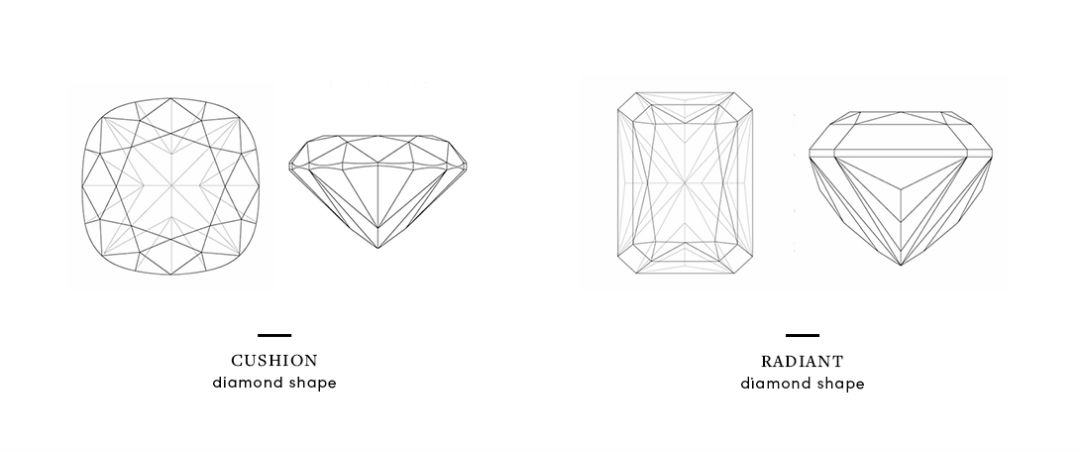
A cushion cut diamond generally has 58 facets, although that can vary. A radiant cut usually has 70. The facets of a cushion cut diamond reach from the culet of the diamond out toward the girdle, resembling a star. The facets in a radiant cut can assume a bit more of an "X" pattern.
The visual effect is very similar, though. From a normal viewing distance, there's no difference except for the shape outline of the stones.
Shopping Advice
Pick whichever you prefer! Weigh the outline most heavily, since that's the biggest difference between a cushion and a radiant. The softer edges of a cushion cut can read more "vintage," while the sharper edges of a radiant can seem more modern. But that can change, depending on the setting.
Price won't rule one out in favor of the other — the two are pretty close to each other in cost. (Check out our comprehensive guide to diamond prices by shape for more information.)
Cushion Cut Diamond Types and Pricing
Fancy shaped diamonds, like the cushion cut, are less expensive than round cut diamonds. That's thanks to their shapes, which make them efficient at using the rough diamond. More of this coveted rough material is sacrificed when creating the round brilliants. But the lower price does come with a trade-off. Fancy shapes have an increased depth and more carat weight inside the center of the diamond, as opposed to on the corners or sides, where the diamond expands. What does that mean? Think of two diamonds, one cushion cut and one round, that are both 1 carat diamonds. The round cut will measure about 6.4mm while the cushion cut diamond will only be about 5.5mm.
Popularity of cushion cut diamond engagement rings has, unfortunately, driven the up the prices of these stones. Luckily, there are several different styles of cushion. One of them, the square cushion cut, tends to be more expensive. That means you stand to save some money on this beloved diamond shape if you opt for an elongated cushion cut or a rectangular cushion cut. (Don't worry, we'll explain what those are.) For many shapes of diamonds, it's important to look at the length to width ratio. The cushion cut is no exception. Square, elongated, and rectangular cushion cuts all have the same basic shape, but differ in their length to width ratios.
Cushion diamonds with a ratio of 1.00 to 1.05 are considered square. These are the most desirable cushion cuts, and tend to cost more. A diamond with a length to width ratio from 1.06 to 1.10 is considered squarish, meaning it is slightly off square. These are also called elongated cushion cut diamonds. The extended length to width ratio on these stones can actually make the diamond look visually larger. Finally, rectangular cushion cut diamonds have a length to width ratio of 1.10 or higher. These diamonds tend to be less expensive by 5% - 10%, when compared to square cushion cuts.
Cushion Diamond Guide
Below you'll find the ideal table and depth for cushion cuts as well as length to width ratio combinations for these stones. One additional important consideration when selecting a cushion cut is the color. Cushions tend to show color more than round diamonds. A G color cushion will look closer to an H color diamond.

Depth % for Cushion Diamonds
Excellent: 66%-56%
Very Good: 70%-52%
Good: 75%-47%
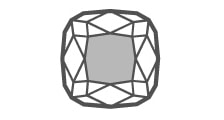
Table % of Cushion Diamonds
Excellent: 72%-56%
Very Good: 77%-50%
Good: 79%-48%
Length to Width Ratio for Cushion Diamonds

1.00
Perfect Square
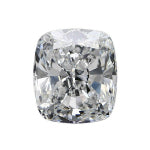
1.10
Short Rectangle

1.20
Long Rectangle
The Actual Price of a Cushion Cut
So you're set on a cushion cut diamond. But we're sure you're wondering what the actual price tag is on this shape of stone. Like all other diamond shapes, cushion cuts are more affordable in smaller sizes, and the prices don't increase at a steady rate. That's because it's very hard to find a rough diamond that's large and clear enough to make a quality diamond in those higher carat weights, like 3, 4, and 5 carat. Once the stone reaches 2 carats, the price shoots up to anywhere from 17,000 dollars to 21,000 dollars. If you look at 4 carat cushion cut diamonds, it's fair to say the price skyrockets. Some even go for 100 grand. But there are plenty of quality stones in smaller sizes, and budget-friendly ways to make your center diamond look bigger than it actually is.
Cushion Diamond Size Chart
Cushion cut diamonds have approximate millimeter sizes that correspond to certain carat weights. Please see a chart of the popular cushion diamond sizes and their carat weights. For all sizes and shapes, please visit our diamond size chart page.

Your Ultimate Guide to Buying a Cushion Cut Diamond
It's easy to understand why cushion cut diamonds are so popular: They command serious attention — thanks to all the light reflected off them — and they're just different enough with the squarish shape and rounded corners to not look like a carbon copy of every other ring in there. But that doesn't mean they all look alike. Stuck on how to buy the right cushion cut diamond for you? We have a few tips to help you get started.
Make Sure you've Picked your Budget and Priorities
It's easy to let your mind — and your wallet — run wild when you're searching for the perfect cushion cut diamond ring. After all, it's a symbol of your love, and you shouldn't spare any expense for something that meaningful. Right?
Well, that's not a good idea, unless your budget truly is endless. While the common advice is to spend two month's salary on a ring, it's not a good rule of thumb — and you shouldn't feel any pressure to stick to it. The truth is that you have other financial priorities to think about (like a wedding and building a life together), so you have to set a budget for how much you want to spend. The average price of a diamond engagement ring is $6,531, but you can set your target for whatever you want and it's likely you'll find a ring.
Balance the 4Cs for a Budget-Friendly Knockout
The caveat here: You'll probably have to prioritize what's important. Your best bet? Look at the four C's of diamonds — carat, cut, color and clarity — and decide which one is a non-negotiable. We suggest making sure cut is a priority, since it's the biggest factor in determining sparkle, and then choosing one more characteristic you think is important. For example, if you must have a 1-carat diamond, you can shave a bit off the price by looking at stones that are 0.8 or 0.9 carats. Called off size diamonds, these stones look virtually identical to the 1-carat stones, but cost a lot less.
You can also save money on a cushion cut diamond by going down a bit on the color scale. Opting for an H-color diamond will save you more than D, E or F-color diamonds, but you won't see a huge difference in its overall look. Just make sure you avoid a crushed ice diamond. While these stunning stones are fantastic for masking inclusions, they’ll amplify the color of your stone. Regular cushion cuts are the opposite: not the best at masking inclusions, but they’re pretty good at hiding a little body color in a diamond.
Another way to save some cash on a diamond: Pay with a wire transfer. At With Clarity, you can snag some serious savings — 1.5 percent of the purchase price (if you're looking at a $5,000 diamond, that's a not insignificant $250) — if you pay for a diamond with a wire transfer instead of a credit card.
Decide What Ratio you Like the Look of Most
Cushion cut diamonds get their name because they're shaped like pillows with a square or almost square style with rounded edges. However, you can also get an elongated cushion cut diamond with one side slightly longer than the other (typically a ratio of 1.1 or 1.2). It might seem like an elongated cushion cut diamond would cost more, but luckily that’s not an issue. The four 4C’s — not the ratio — determines the price of the stone.

Work with a Gemologist on Faceting you Prefer
Facets are the surfaces of the diamond that help reflect the light and give it that sparkling look we all love. Cushion cut diamonds are brilliant diamonds, meaning they’re cut to maximize the brilliance of the stone (aka they have more facets). However, cushion cut diamonds have different faceting than other brilliants, like round cut diamonds.
Although they're all brilliants, there's the cushion brilliant, cushion modified brilliant and the hybrid between these two. The cushion modified brilliant has the most "crushed ice" appearance of them all, which some people prefer. Some stones are also simply crushed ice diamonds. The hybrid has some of this, though less than the plain cushion brilliant.
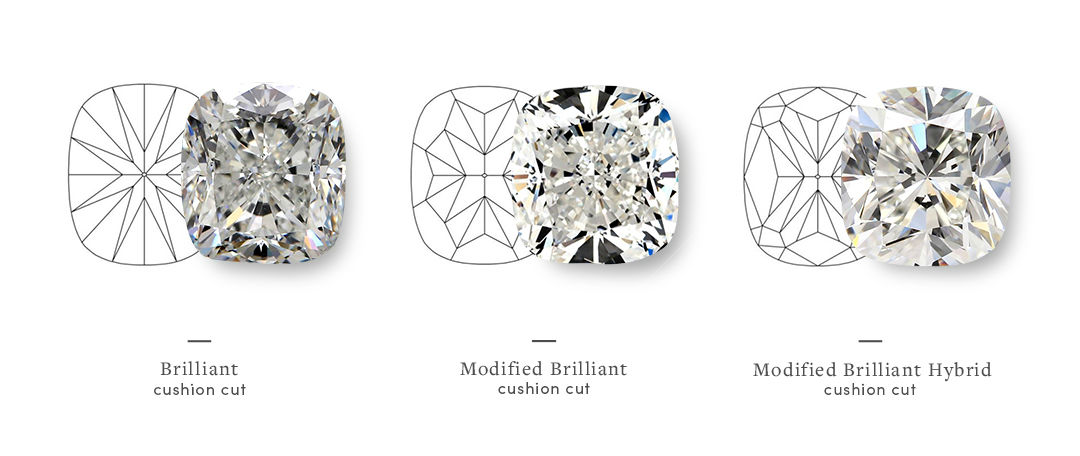
Confused? We understand. That's why working closely with an expert is the key, although you should keep in mind that there's no wrong answer. Choosing between faceting is all about personal preference, and you can read on a couple sections lower down for more about this. At With Clarity, we have expert gemologists on staff who can work with you to find the right faceting for your cushion cut diamonds. Even better: They'll evaluate your must-haves — and your budget — to find several different rings she's sure to love.
Antique Cushion Cuts
Cushion cut was one of the first shapes among diamonds and many antique cushions are still in circulation today. The vintage look has fewer, longer facets than its modern brilliant cushion cut cousins, and this style of cutting comes from the early-mid 20th century. Generally, the antique cushion cuts are less brilliant than brilliant and modified brilliant cut cushions because the cutters of that time period did not have the skills or technology to optimize brilliance, which requires precision in cutting and polishing. You'll see open culets, misshapen facets and shallow diamonds with steep crown angles in these stones. (All of these things diminish how light is reflected back at you, which lessens brilliance.) The antique cushion diamonds do have a sense of beauty though, and the vintage, handcut nature makes for a cushion cut ring with unique charm. If this appeals to you, look for a jeweler who sells cushion cut vintage engagement rings.
Cushion Modified Brilliant vs. Brilliant Cut
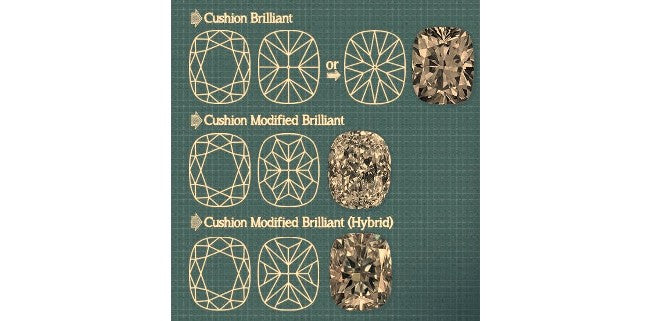
You'll see many people comparing cushion cut vs round because the cushion brilliant diamonds have very similar faceting arrangements as round brilliant cut diamonds. The facets in the pavilion (or lower portion) of a cushion brilliant reach from the culet of the diamond out toward the girdle, resembling a star. (See the diagram of the different cushion brilliants to visualize all the technical language.) Cushion brilliants also contain larger facets and look more like an X when viewed through the table facet face up. Essentially this means they resemble round cut diamonds with soft edges. What does that mean for you? These cushion diamonds are in high demand, so they might carry a premium compared to other cushions. But it might not be the type for you if you like the look of a rectangular cushion cut diamond, since it's far more common to see the cushion brilliant in the square shape.
Cushion modified brilliants, on the other hand, are a newer version of the original cushion brilliant shape. These diamonds contain an extra row of faceting below the girdle, which then more closely resembles a flower. (You can see this in the diagram.) This is done to increase the amount of brilliance. More facets mean more surfaces for the light to bounce around, making that blinking effect that we cherish as a diamond's sparkle. Cushion modified brilliants look more like crushed ice or flowing water when you see them reflect light, similar to the radiant cut diamond. For this reason they're also called crushed ice diamonds. Manufacturers like this cut because it saves precious rough diamond material. So what does that mean if you like this style? Good things. They're pretty common, so it should be easy to find, and they should be less expensive because they're not as popular as the cushion brilliants.
To figure out whether the cushion diamond you're considering is a brilliant or a modified brilliant, you can look at the GIA diamond report. Check the report plot for cushions above 1.00ct. They will show you the diamond plot so you can identify the cut. But we have expert gemologists on staff here at With Clarity to make it easier for you. Get in touch with one and let them know which type of cushion you prefer, and they'll perform a diamond search for you to your exact specifications.
FAQs
What is a cushion cut diamond?
Do cushion cut diamonds look larger than round?
Are cushion cut diamonds more expensive?
What is a cushion cut diamond ring?
What is a modified cushion diamond?

